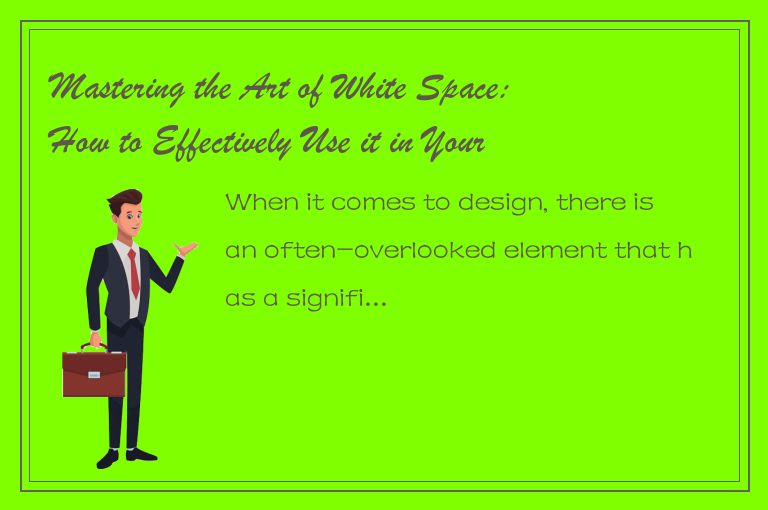When it comes to design, there is an often-overlooked element that has a significant impact on the overall composition. We’re talking about whitespace, also known as negative space. It’s the area between elements in a design, the space between lines of text, or even the margins around a page. Many designers see whitespace as empty or wasted space, but in fact, it is an essential component of design that can affect the overall visual hierarchy and balance of a design.
In this article, we will delve into the importance of whitespace and how to effectively use it in your design.

What is White Space?
White space is the area between design elements, whether they are lines of text, graphics, or photos. It's the space that is left intentionally blank but plays a crucial role in creating a clean and organized design. White space doesn't necessarily have to be white; it can be any color or background.
Why is White Space Important?
White space enhances the visual hierarchy, making it easier for the viewer to understand the content and the key points of a design. It can create balance and harmony, offsetting the design's different elements, creating a sense of symmetry and order. Imagine a website with a series of text blocks crammed together, where there’s barely any space between the lines, how will the viewer comprehend the information? It's hard to read and visually overwhelming.
On the other hand, when you add white space, it breaks up the text, creates visual separation between ideas, and makes the content easier to read.
White space can also be useful in organizing the graphic design elements precisely. A poster with text, images, and illustrations can quickly become overcrowded, with everything vying for attention. However, space between the elements can give a focal point to each component, prioritizing the hierarchy of the important elements.
Examples of Effective Use of White Space
Here are some examples of design where white space was used effectively:
1. Apple
Apple designs are well-known for their simplicity and minimalist approach. Look at the company's website; there's ample white space around the products, making them the center of attention. The overall design is clean, uncluttered, and easy to comprehend.
2. Airbnb
Airbnb’s website is a great example of effective use of white space. The homepage features a significant amount of space between photos, headlines, and text. The simple background and the absence of clutter create a sense of calm and clarity that compliments the company's travel-focused values.
3. Nike
Nike has mastered the use of whitespace by leaving noise out of their website. The bold typography and subtle color choices allow ample room for the images and product information to breathe. The clean design further reinforces the brand's message of uncomplicated excellence.
How to Effectively Use White Space in Your Design
Now that we understand the importance of white space let's look at how to utilize it effectively to create visually appealing designs.
1. Consider the Content
The type of content you’re designing dictates the white space you should use. Text-heavy designs, such as books or reports, require more white space, making it easier to read. Images and graphics, on the other hand, can have less white space. Before figuring out the white space to incorporate in your design, you must consider the type of content.
2. Maintain Balance
Maintaining balance is vital when designing with white space. Balance can be achieved by ensuring text is evenly placed, having symmetrical elements in the design, or creating breathing room. Design should be neither overcrowded nor over simplified; you should aim for a perfect balance.
3. Use White Space Purposefully
White space should be used intentionally and deliberately to help create the design's overall look and feel. You may use it to highlight an essential element or create a sense of spaciousness. The goal is to use whitespace to enhance the other design elements, not detract from them.
4. Don’t be Afraid of White Space
Design can't be overloaded or cluttered with too many elements; that's why white space is essential. You may fear that too much whitespace could create a bland, unappealing design, but that needn't be the case. An ample amount of whitespace can make a design look elegant, minimalist, and modern.
Conclusion
White space is a valuable tool when used correctly. It adds visual appeal and provides a balance that brings your design alive. The principles for using white space can be challenging to understand, but once mastered, it can make a designer's work appear seamless. Incorporating plenty of white space is part of a broader movement towards simplicity and minimalism. It’s not about leaving things out, but about finding the right balance to create visually appealing designs. By mastering the art of white space, you'll be able to bring your design to life and create compelling, eye-catching visuals that are sure to draw attention.




 QQ客服专员
QQ客服专员 电话客服专员
电话客服专员